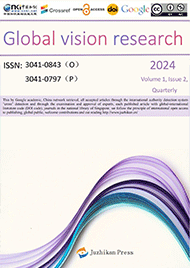 65 84368249
65 84368249 info@juzhikan.asia
info@juzhikan.asia 65 84368249
65 84368249 info@juzhikan.asia
info@juzhikan.asia
Art in Science: The Dilemmas and Innovative Research on Aesthetic Education Practice for STEM Graduate Students in the Digital Age
Yingling Guo Shiyu Lan
Guangdong University of Finance and Economics,Guangzhou,510220;
School of Statistics and Mathematics, Guangdong University of Finance and Economics, Guangzhou,510220;
Abstract:This study focuses on the significance and challenges of aesthetic education for graduate students in science, technology, engineering, and mathematics (STEM) fields in the digital era. Through a literature review, the study analyzes the current status and deficiencies both domestically and internationally, such as superficial research on aesthetic education content, misaligned teaching objectives, utilitarian evaluation systems, and the neglect of aesthetic education resources by higher education institutions. The research emphasizes the value of aesthetic education in fostering innovative thinking, enhancing the quality of life, and promoting interdisciplinary communication. In response to the challenges of theory-biased teaching, student cognitive biases, limited innovative thinking, and the integration of technology and art, the study proposes innovative pathwayssuch as strengthening digital management, innovating teaching models, optimizing the technological environment, and constructing intelligent platforms to enhance the level of aesthetic education, meet personalized needs, and promote the integration of aesthetic education with STEM education. This provides decision-making references for universities and educational departments, and promotes innovation and development in the practice of aesthetic education.
Keywords: STEM, Aesthetic Education, Digitalization
References
[1] Lee, Min Jung. Aesthetic Education for Children: Public/In-Between Space, Happiness, and Identity [D]. The Pennsylvania State University, 2011.
[2] Denac, Olga. The Significance and Role of Aesthetic Education in Schooling [J]. Creative Education, 2014.
[3] Kosinova, Elena. Aesthetic Education as an Actual Training Direction for Art High School Students [J]. National Academy of Managerial Staff of Culture & Arts Herald, 2015.
[4] Zolotareva, Olga. The Aesthetic Potential of Mathematics Education [J]. Concept / Koncept, 2013.
[5] Fan, Yiting. Study on Aesthetic Education Methods in College Physical Education Teaching [J]. Advances in Social Science, Education and Humanities Research, 2016.
[6] Hinchion, Carmel. Embodied and Aesthetic Education Approaches in the English Classroom [J]. English in Education, 2016.
[7] Ornelas, M. The Virtual Classroom: Art Education for Itinerant Students [J]. Observatorio, 2012, 6(2).
[8] Katsaros Molzahn, Maria. Art Education: A Tool for Talent Development for Underrepresented Gifted and Talented Students [J]. US-China Foreign Language, 2020, 18(12).
[9] Zhang, Shiqin, Wang, Na, Ke, Yang, et al. Exploration of Aesthetic Education Practice for Graduate Students under the "Double First-Class" Initiative [J]. Science Consulting (Educational Research), 2021(07): 152-153.
[10] Shen, Wei. Design Education and Social Aesthetics for Doctoral Students [J]. Fine Arts Overview, 2011(09): 158-159.
[11] Xu, Jing, and Zhang, Qing. The Role of Aesthetic Education in the Innovative Training of Graduate Students and Promotion Measures [J]. Journal of North China University of Technology, 2017, 29(06): 72-77.
[12] Li, Jun. The Current Status of Graduate Students' Aesthetic Literacy and Countermeasures for the Implementation of Aesthetic Education: A Survey Study of Graduate Students from 9 Universities in Jiangsu Province [J]. Art Education, 2020, (09): 227-230.
[13] Jiang, Diankun, and Li, Yinghu. On the Value, Connotation, and Form of Aesthetic Education for Graduate Students in the New Era [J]. Degree and Graduate Education, 2023, (12): 27-32.
[14] Sun, Xiaojian. Integration Practice Research on the Core Literacy of Aesthetic Education for Graduate Students in Fine Arts [J]. Chinese National Fine Arts, 2021, (04): 80-81.
[15] Yang, Jie. Research on the Relationship between Aesthetic Education and the Cultivation of Innovative Abilities of STEM Graduate Students [J]. Yinshan Journal, 2009, 22(02): 8-13.
[16] Xiao, Han. A Brief Discussion on the Role of Aesthetic Education in the Training of Graduate Students in the New Era: Taking Huazhong Agricultural University as an Example [J]. Art Education, 2020, (05): 30-33.
[17] Huang, Bin. Exploration of Aesthetic Education Practice for Graduate Students under the "Double First-Class" Initiative [J]. Chinese Graduates, 2019(06): 48-53.
[18] Wang, Xiaoyong, and Xu, Jing. Cultivating Virtue, Inspiring Innovation, and Healing with Aesthetics: Opportunities for Integrating Aesthetic Education into Graduate Education and Considerations for Its Implementation in Training Programs [J]. Aesthetic Education Journal, 2023, 14(04): 20-26.
[19] Dai, Binxian, and Wang, Zhiyang. Exploration of the Development of Experiential Aesthetic Education in Colleges and Universities in the Digital Age [J]. Research in Art Education, 2024(03): 130-132.
[20] Xu, Mengjie. Aesthetic Education in the Context of New Liberal Arts in the Digital Age: Connotation, Challenges, and Path Construction [J]. Higher Education Exploration, 2023(04): 114-121.
[21] Zhang, Wei. Exploration of the Application of 5G-Based VR/AR Interactive Classrooms in Higher Education Teaching [J]. Chinese Journal of Multimedia and Internet Teaching (Mid-Month Edition), 2022(01): 1-4.
[22] Meng, Weiqing, and Wu, Kaijun. The Transformation of the Quality Assessment System for Graduate Education in Japan: Experiences and Issues [J]. Continuing Education Research, 2010(06): 65-68.
[23] Quan, Meilin. The Transformation and Innovation of Graduate Education Management in the Big Data Era [J]. Modern Communication, 2020(23): 46-48.
[24] Wang, Zhanjun, and Lin, Genrong. Dynamic Monitoring: A New Paradigm for Graduate Education Management Driven by Big Data [J]. Research in Graduate Education, 2022(02): 1-8.
Author's Profile: Yingling Guo (September 17, 1991) Female, from Shenzhen, Guangdong, holds a Master's degree, ethnicity: Han, is a teacher at the School of Statistics and Mathematics, Guangdong University of Finance and Economics, job title: Higher Education Management Research Intern, research areas: Higher Education, Aesthetic Education. Unit Postal Code: 510220, Guangzhou, Guangdong Province.
Author's Profile:Shiyu Lan (School of Statistics and Mathematics, Guangdong University of Finance and Economics, Guangzhou, Guangdong 510220.)(2002.0302) Female, She ethnic group, from Heyuan, Guangdong, majoring in Statistics (Science), School of Statistics and Mathematics, Guangdong University of Finance and Economics, Research direction: Mathematical Statistics Mailing address: North Gate, Guangdong University of Finance and Economics, Guangzhou, Guangdong, Postal code 510220,